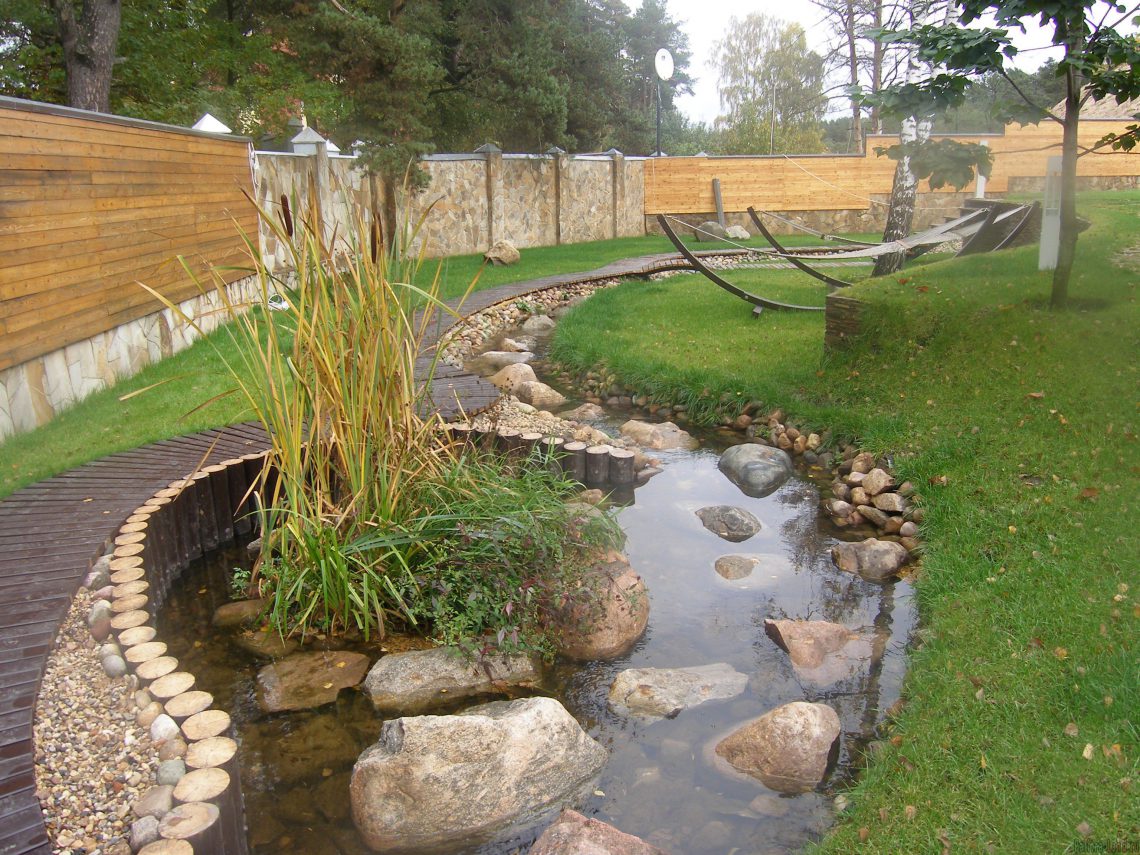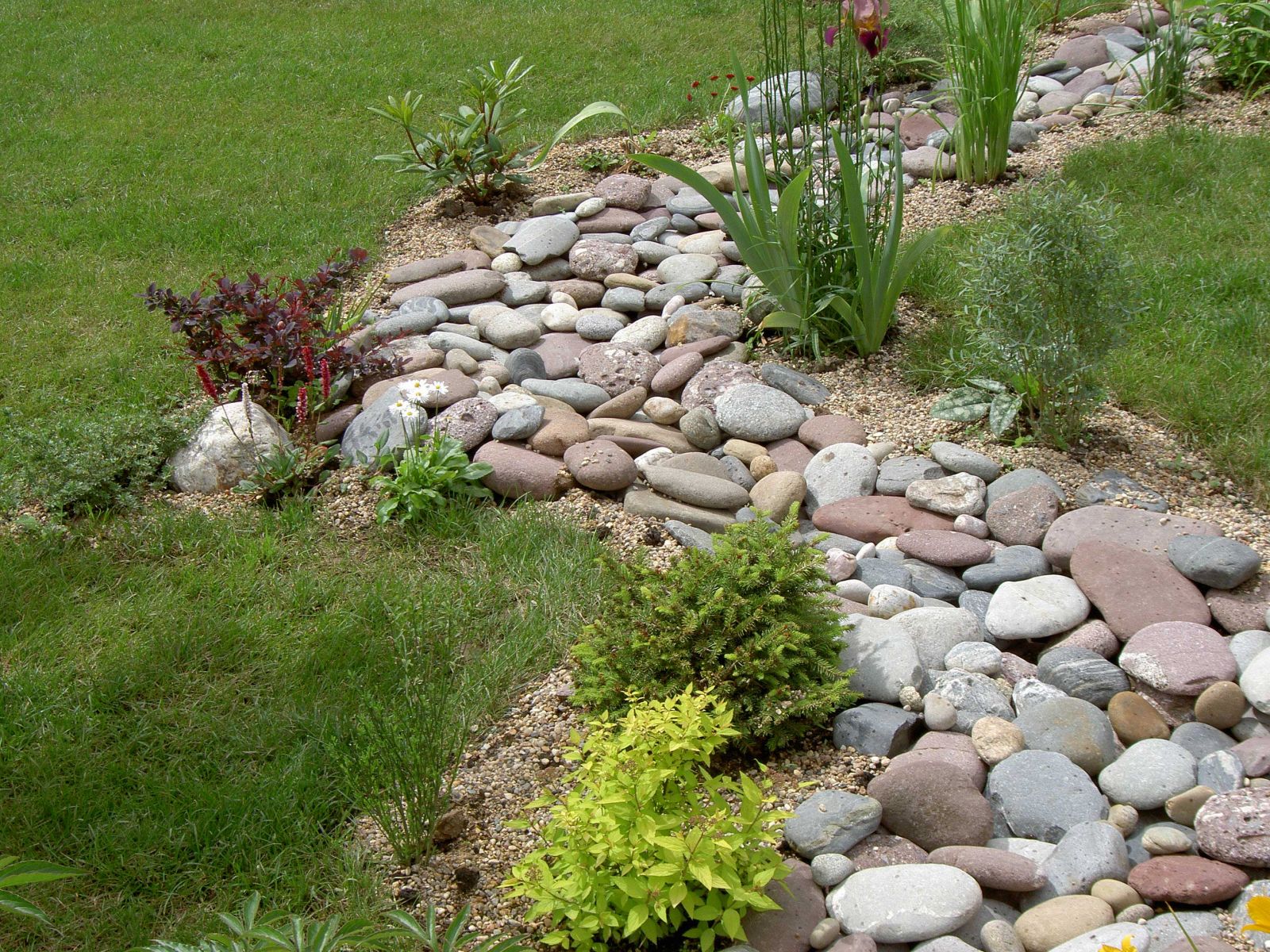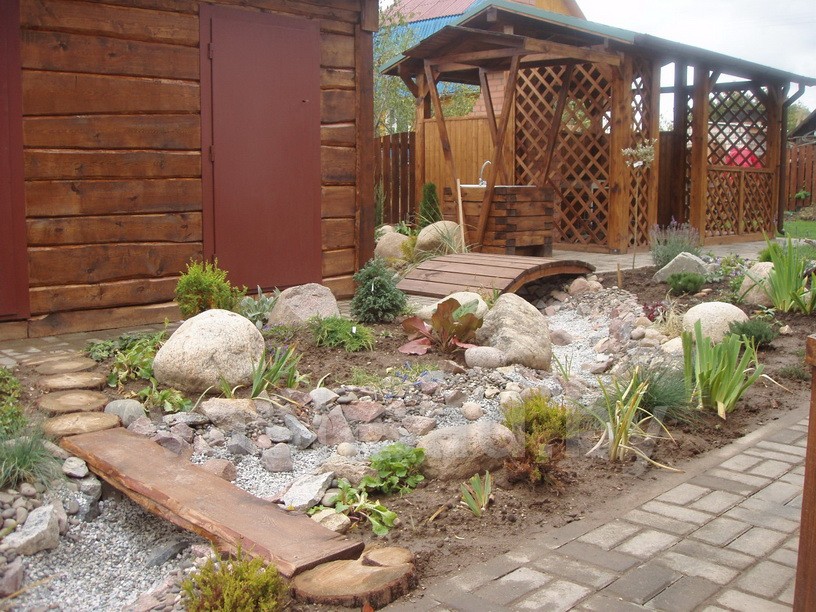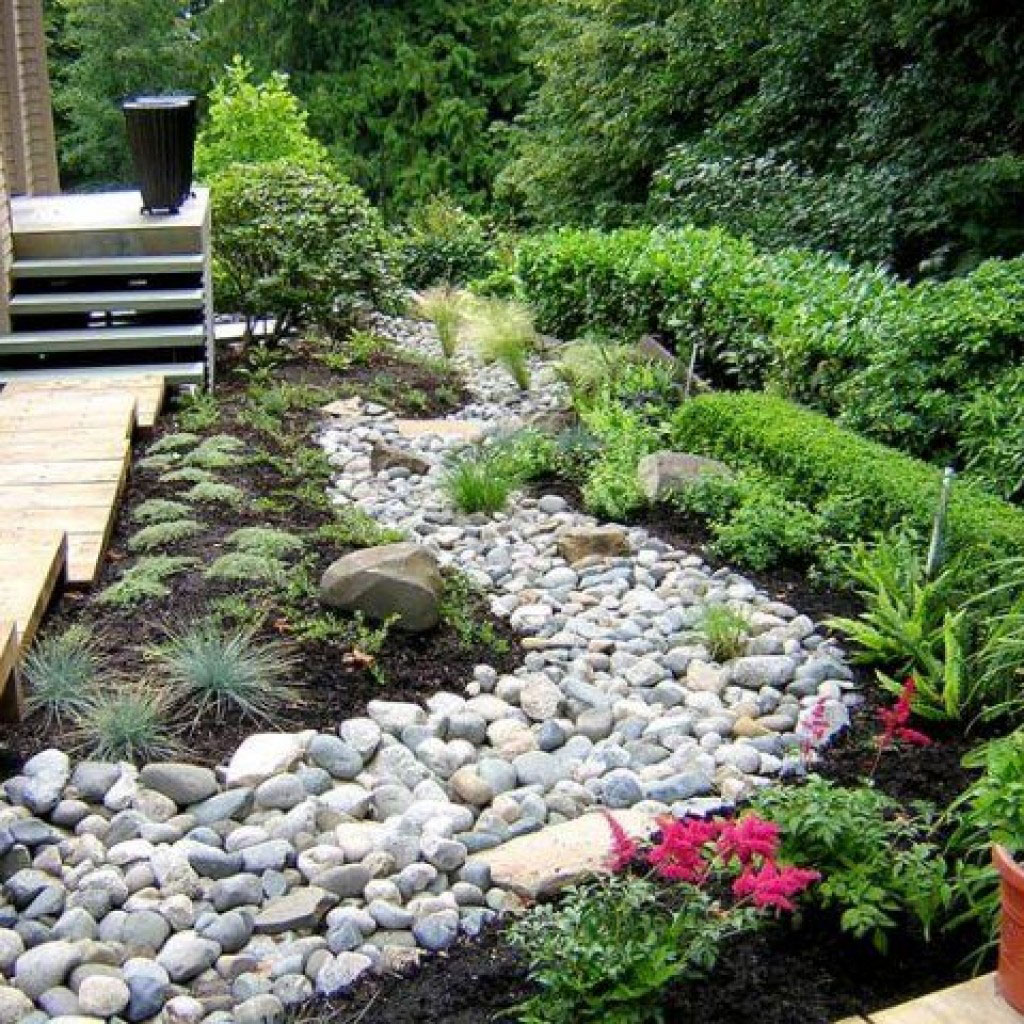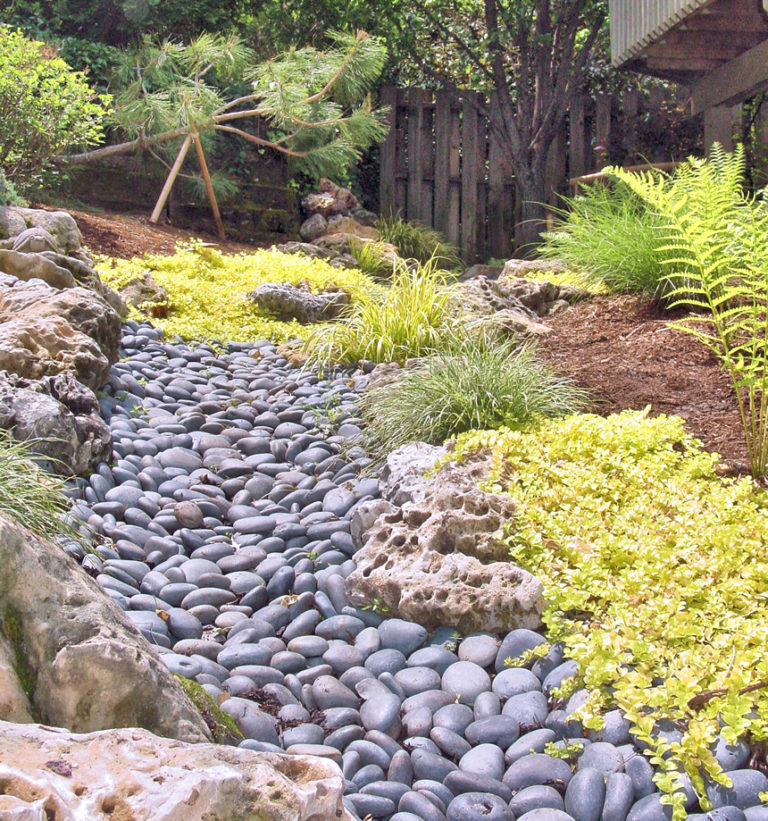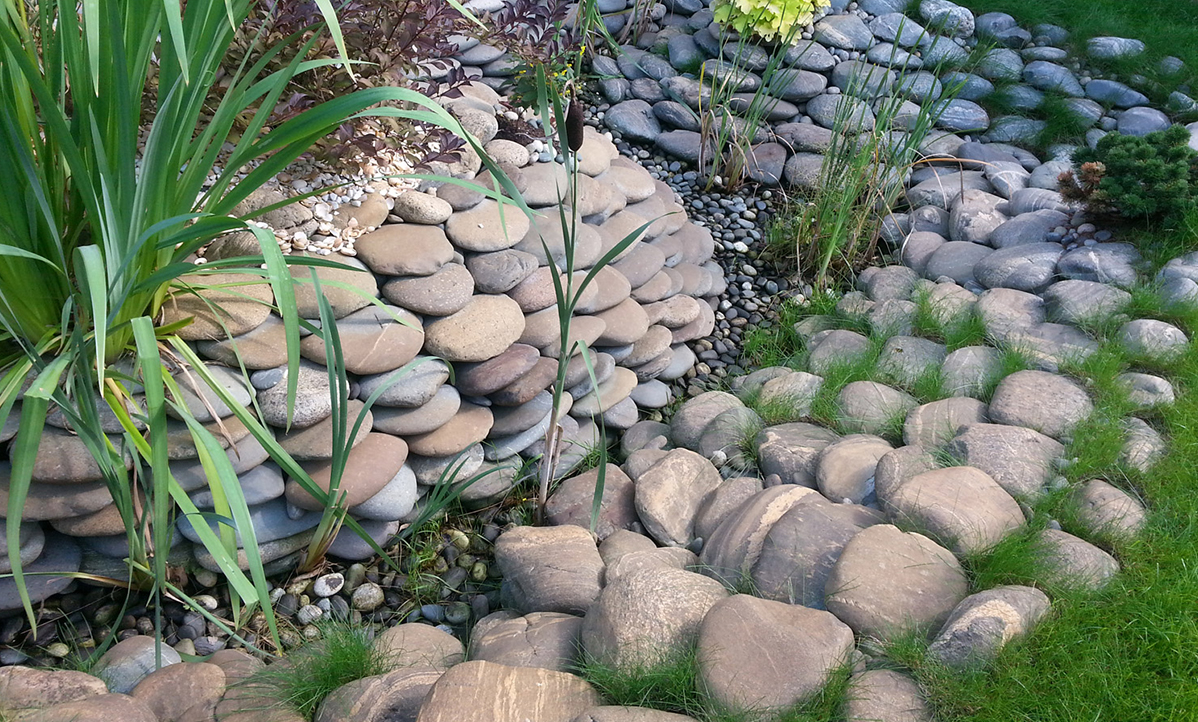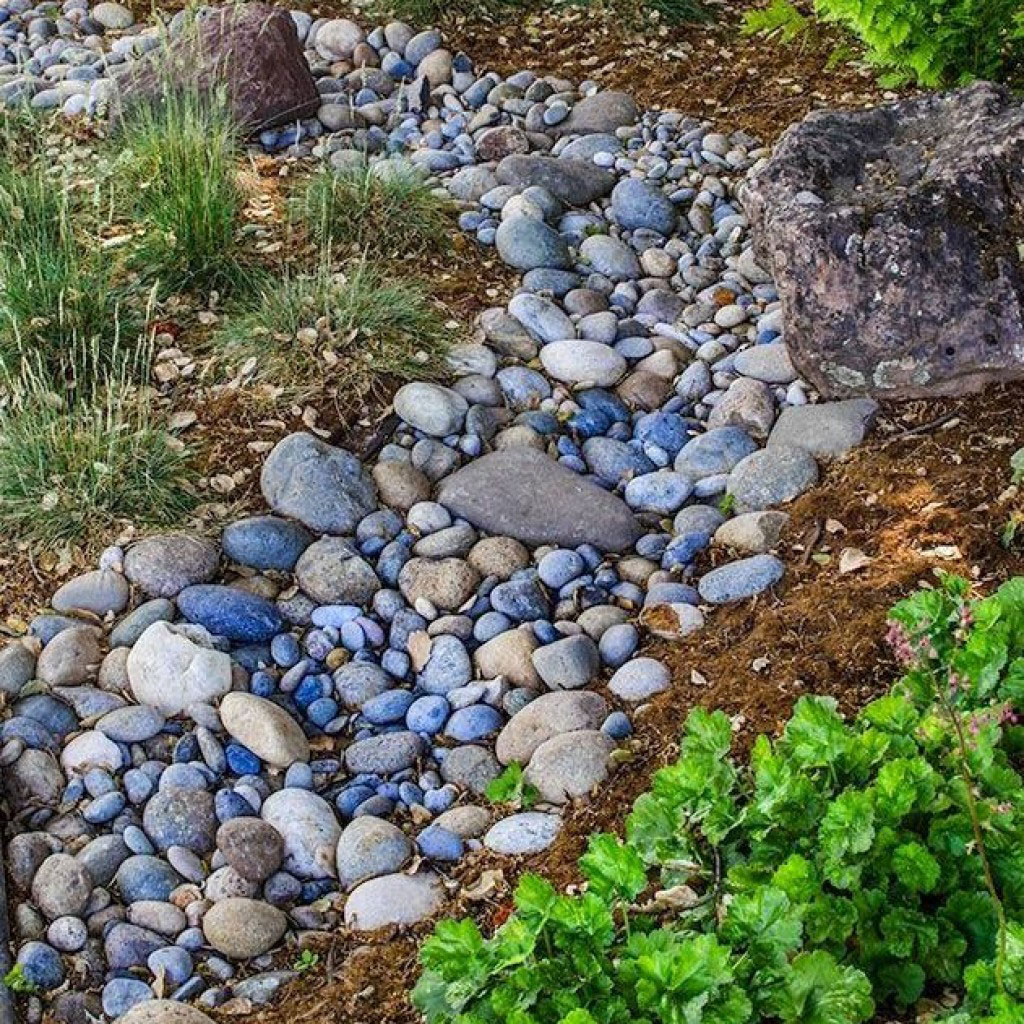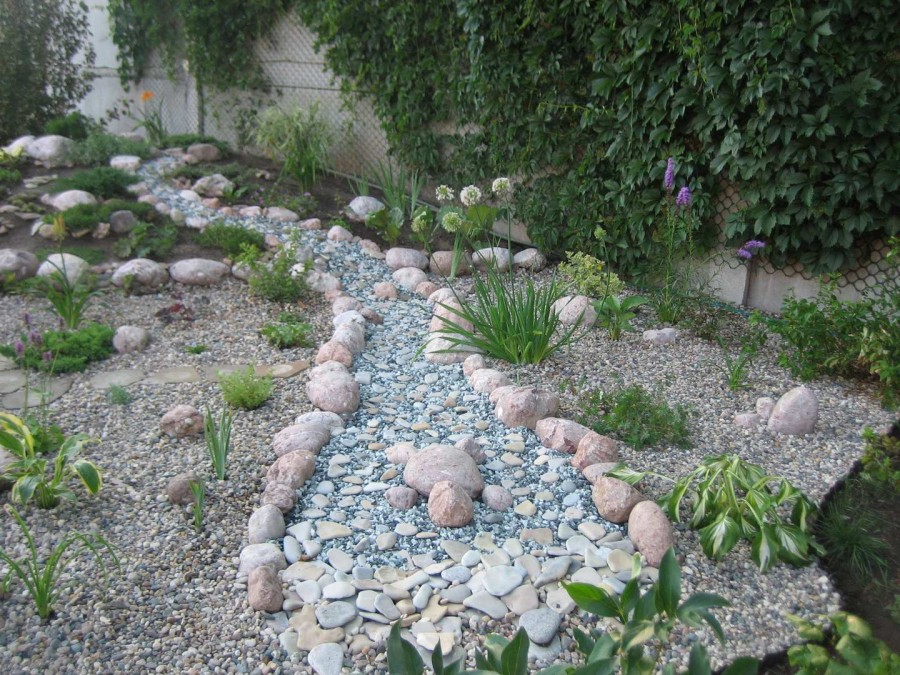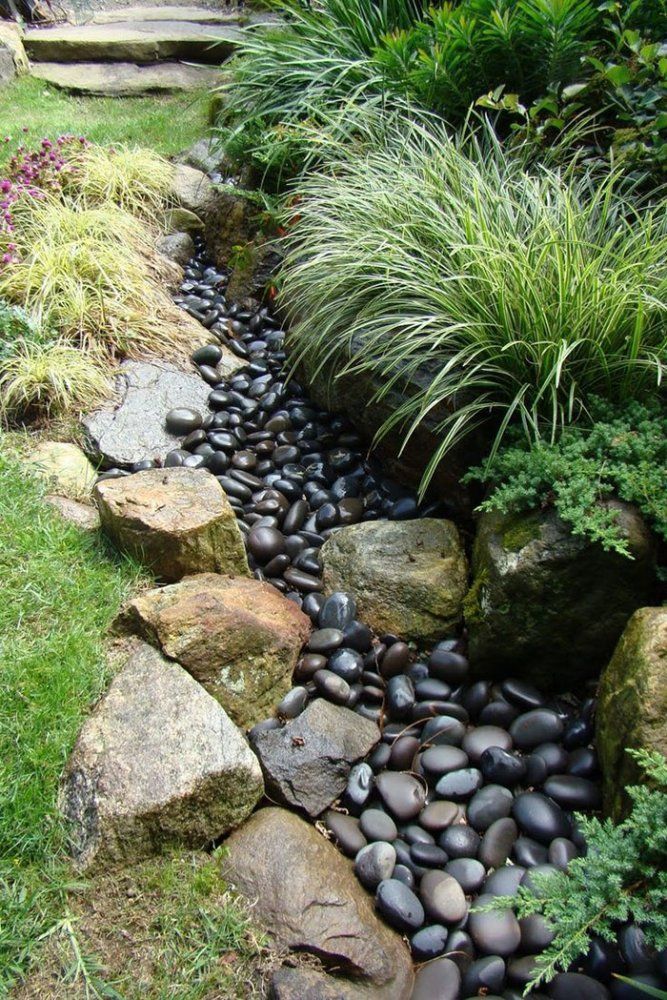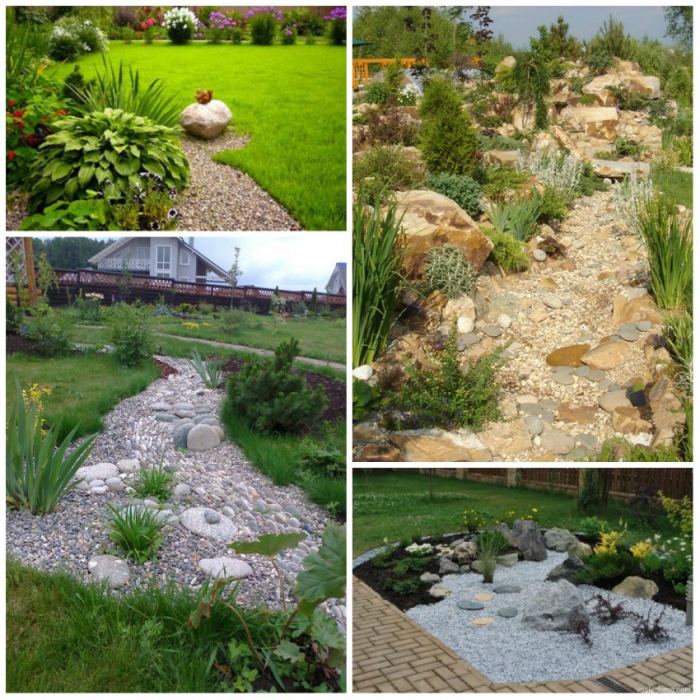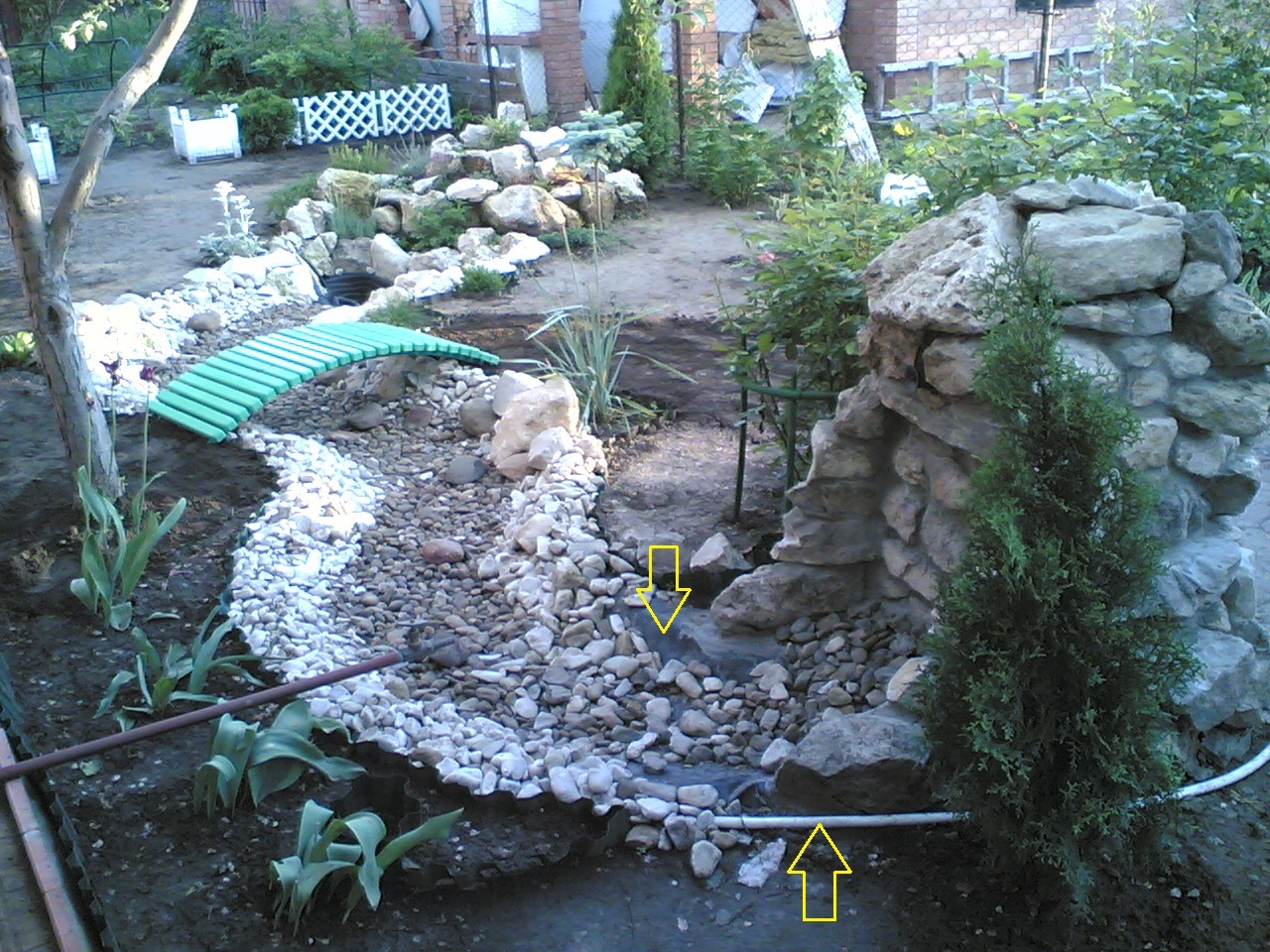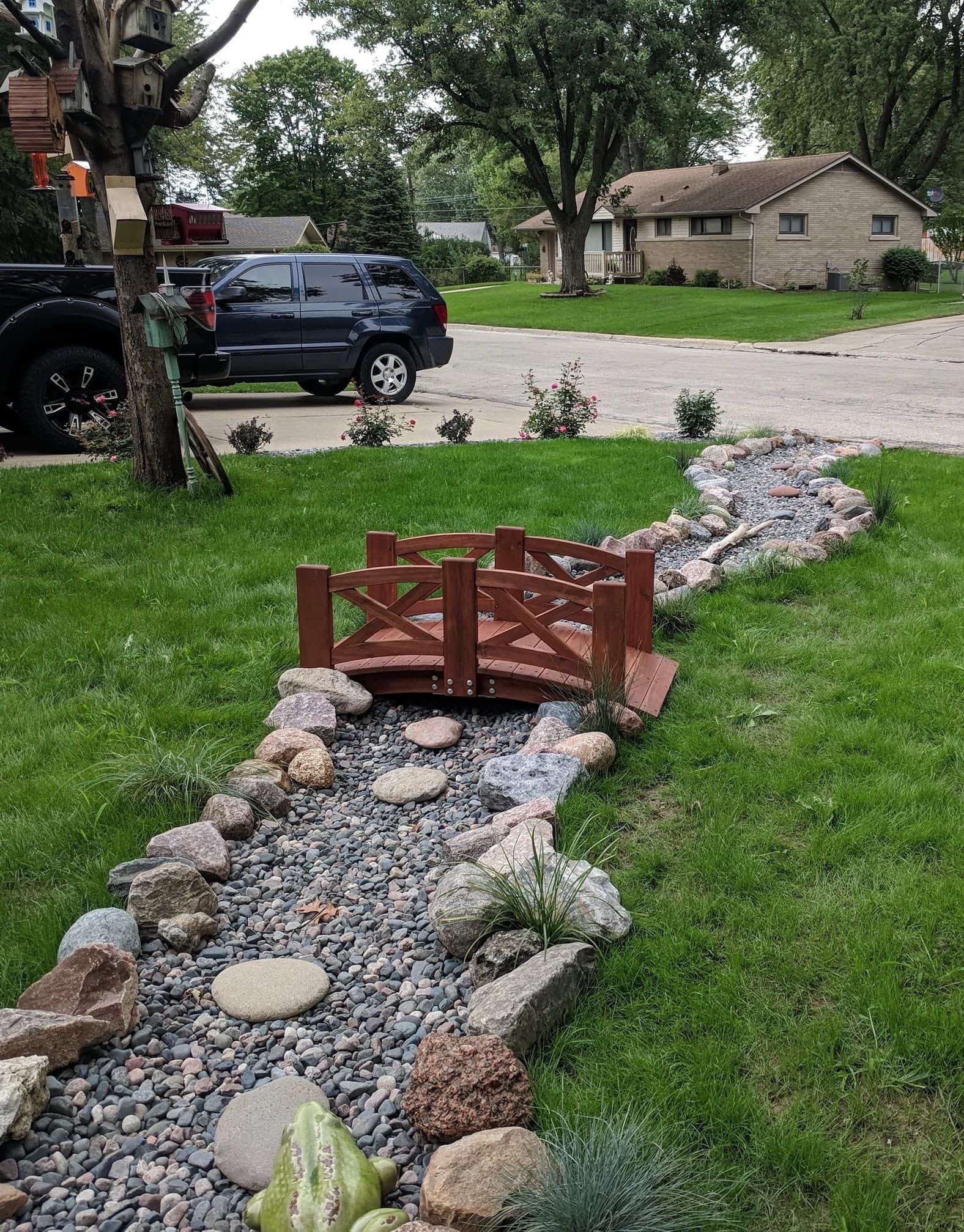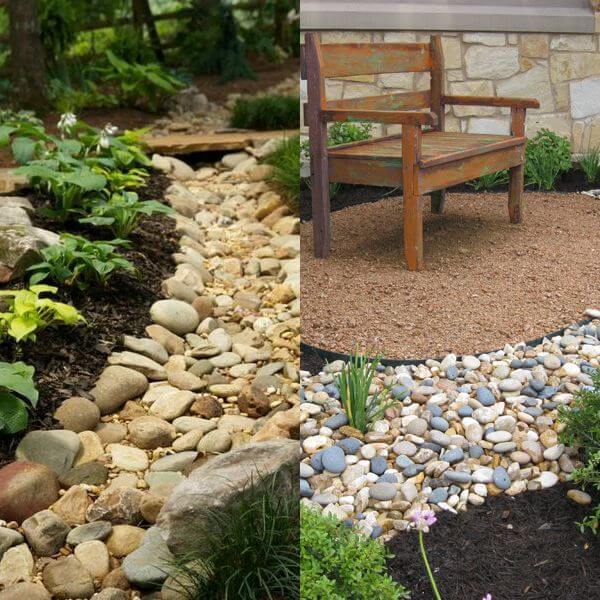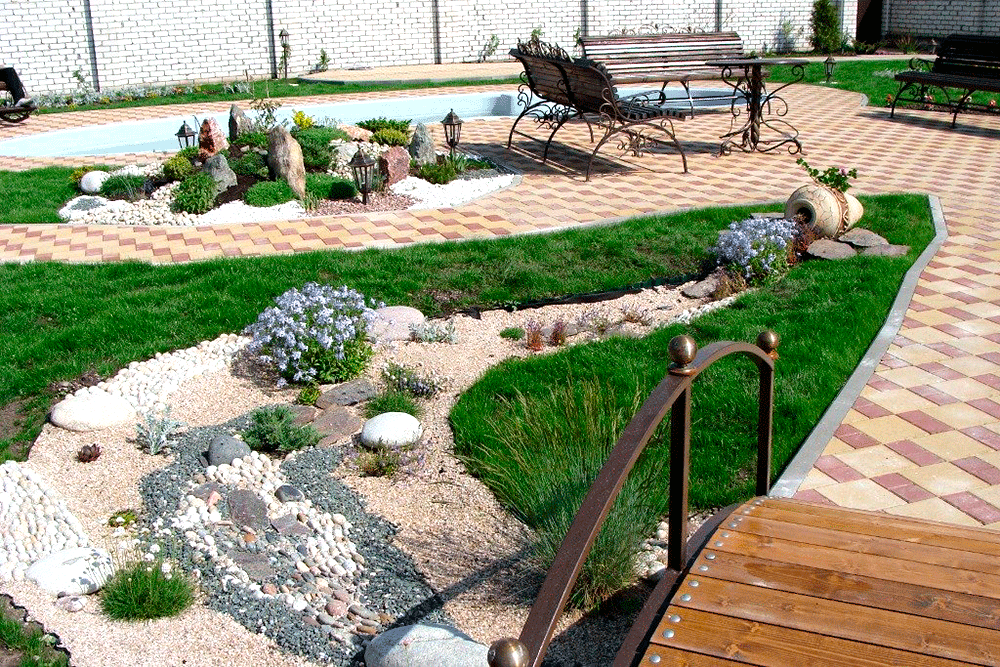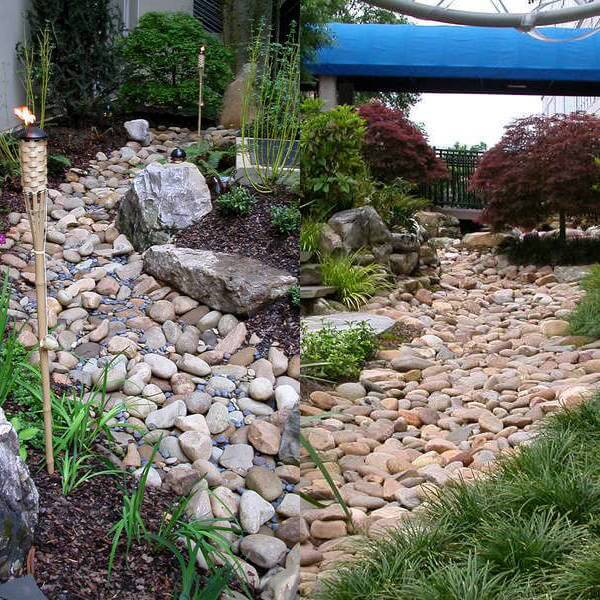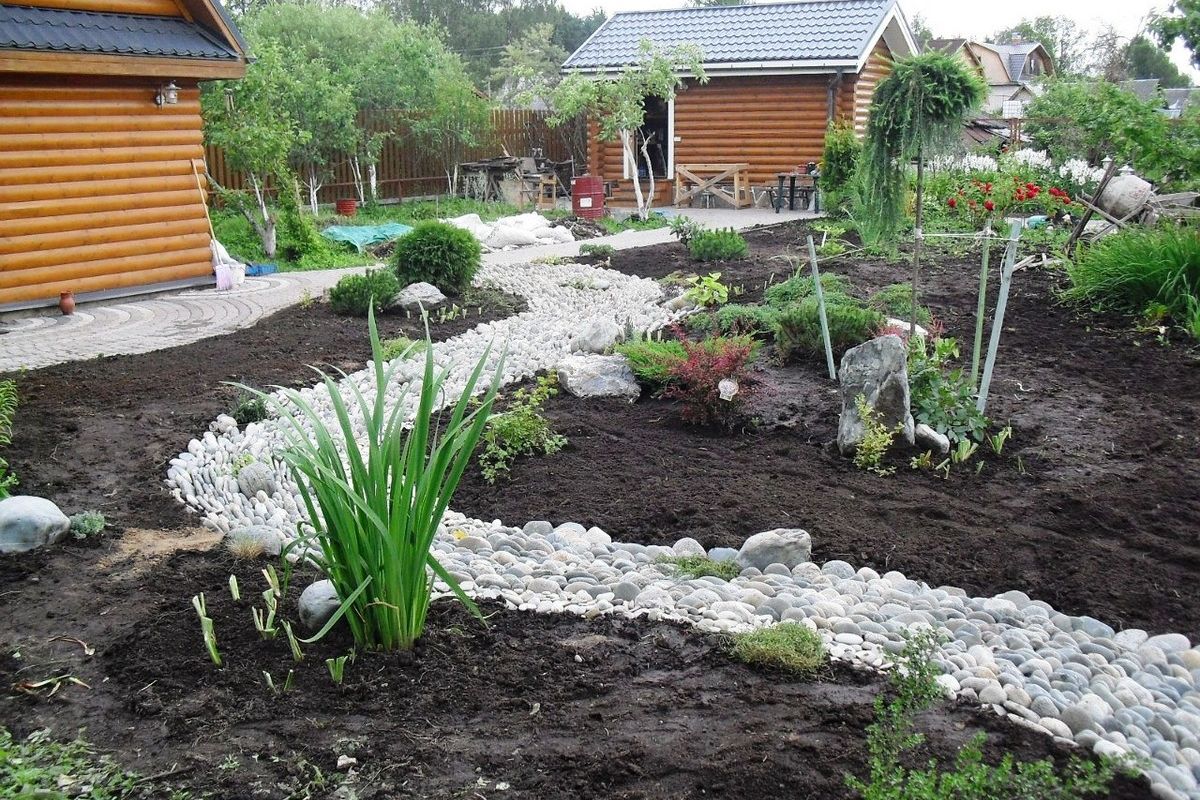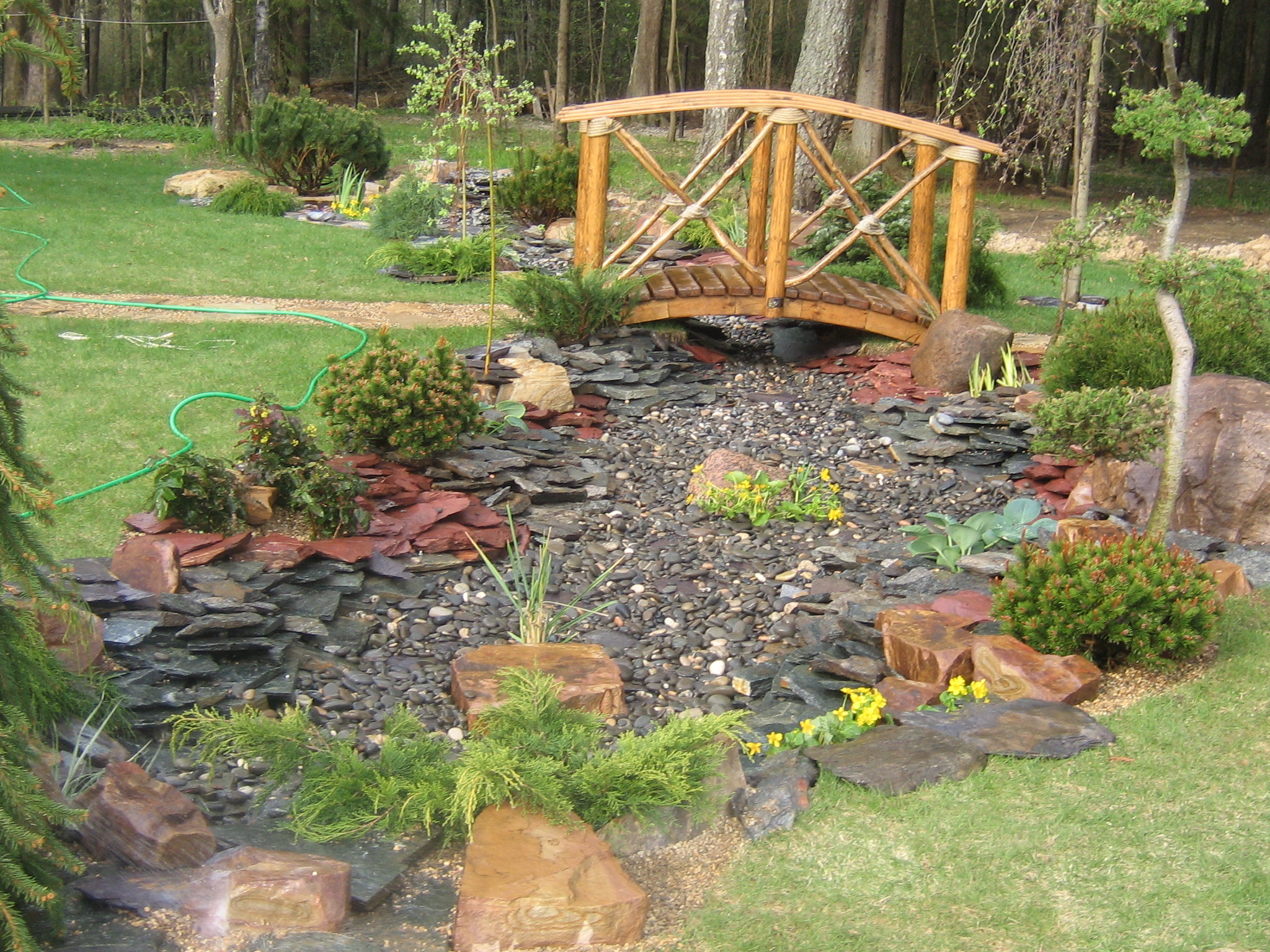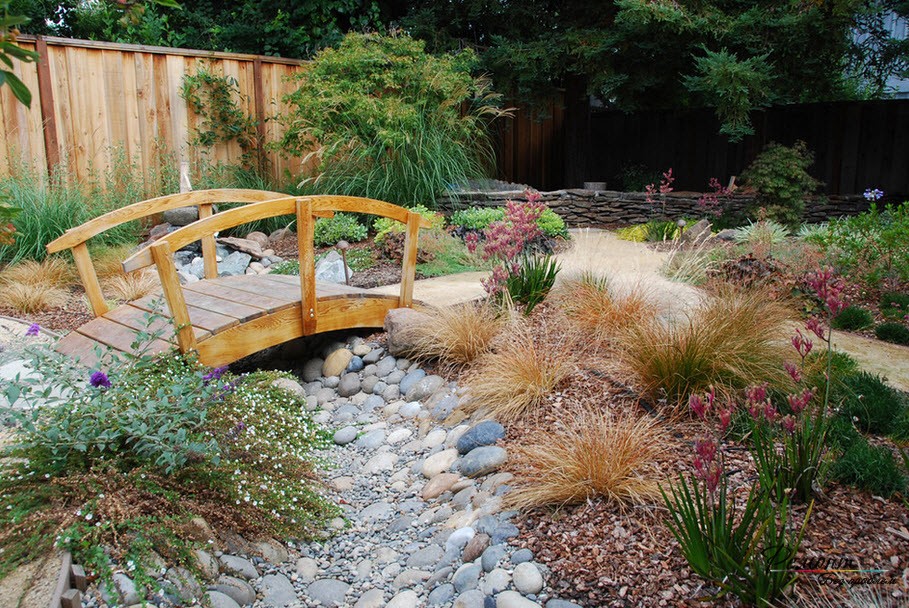Application in design
You can use the listed types of dry streams for:
- zoning space into areas characterized by distinctive features;
- adjusting the proportions of the suburban area (expansion, visual increase);
- masking (if necessary, hide, for example, laid pipes);
- creation of a drainage system and drainage system.
The variety of design fantasies is represented by the way materials are laid. For example, if you want to create an imitation of a dry riverbed, then it is better to use homogeneous pebbles, which should be evenly smoothed. In the case of laying out such a pattern on the surface with large boulders, there is a feeling of the naturalness of a dry stream, from the bottom of which pitfalls opened to the viewer's eyes. Waves and ridges are used to form the semblance of water. In this case, the bulk material is laid out in a wave-like, figured manner, at different levels.
We select stones
You have decided on the place and type of dry stream, now we are preparing the materials. We need a covering material, various stones and, of course, plants.
The basis of any type of dry stream are stones, so you need to be very careful about their selection.
Large rough stones will be needed to form and secure the banks of our stream. And to create the flow itself, you need finer material (pebbles, crushed stone). In order for the dry stream to organically fit into the already existing style of the garden, it is advisable to use stones in its creation that have already been used in the decoration of the house or the design of the site. Some designers recommend using a natural material for your area for greater naturalness.
If your goal is to create the most natural imitation of a dry riverbed, then the emphasis should be on stones in a gray-blue color scheme: slate, pebbles, gneiss, basalt. Limestone, white marble and granite provide light shades. Granite will allow you to get even greenish and brown tones.
Creates a very beautiful illusion of a rushing stream of flat pebbles laid vertically or with a slight layering
It is important here to move the stones relative to each other, creating the effect of movement. It is necessary to place them tightly together and fasten them well.
Colored marble chips and sand will help create a simulated water look. Soft pastel colors will do. You can make a simple pattern of two or three shades, or use only one tone.
Large beautiful boulders, located singly or in small groups in the middle of the stream, will imitate backwaters.
Large flat stones can be used to make cascading steps near the waterfall.
The glittering effect of the water can be achieved by using glass beads or granules of various colors. The perfect natural shine will be provided by transparent or blue-green balls, and bright yellow-orange ones will add mystery.
How a dry stream will turn out depends entirely on your choice, due to imagination and preferences. However, it is better not to get carried away and stick to a sense of proportion.
Decoration
The right plant environment will turn a dry stream into a real work of art. It is preferable to choose herbs and flowers, one of their kind evoke associations with water and at the same time grow in an ordinary garden. In order not to turn the stream into a flower bed, you should not overload it with vegetation. It is also not recommended to use tall plants when decorating a narrow stream.

When choosing plants for decorating a stream, perennials should have an advantage, this will allow for a long time not to destroy the stone base for planting new plants.For planting the banks of the stream, krasodnev, creeping tenacious, fan, pampas grass, bell, leaf grate bamboo, blue fescue are used. The coolness of the reservoir will be reminded of arundo reed, lobelia, large-leaved forget-me-not flower, Poskharsky's bell, large-leaved brunner, bison grass, hosts. On the bank of a wide stream, tall grass, shrubs and even short trees will naturally look. A swing wooden bridge will become an excellent attribute, it will emphasize the naturalness of a dry stream.
When forming a dry stream, its creator must use maximum attention and all his accuracy, since this piece of landscape design is created for years. Having made an effort once, you can enjoy the splendor and beauty of this unusual structure for a long time, which came to the garden plots from the mysterious East.
Diy photo of a dry stream
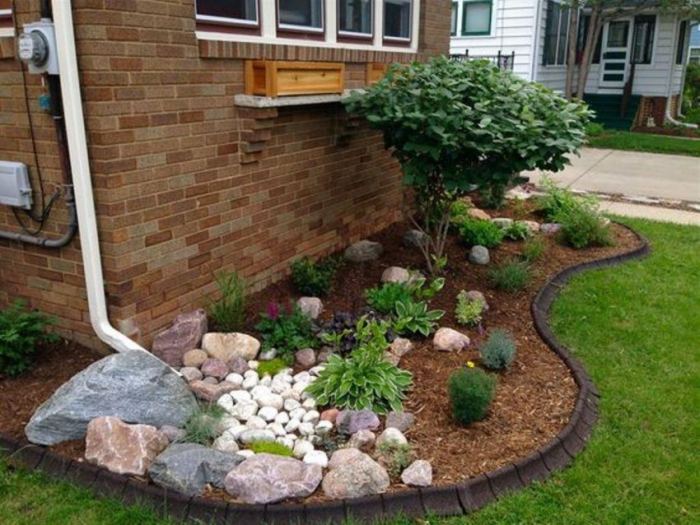
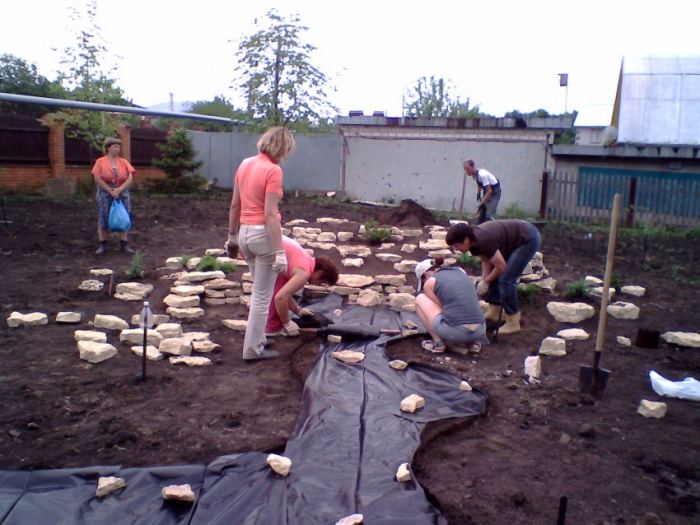

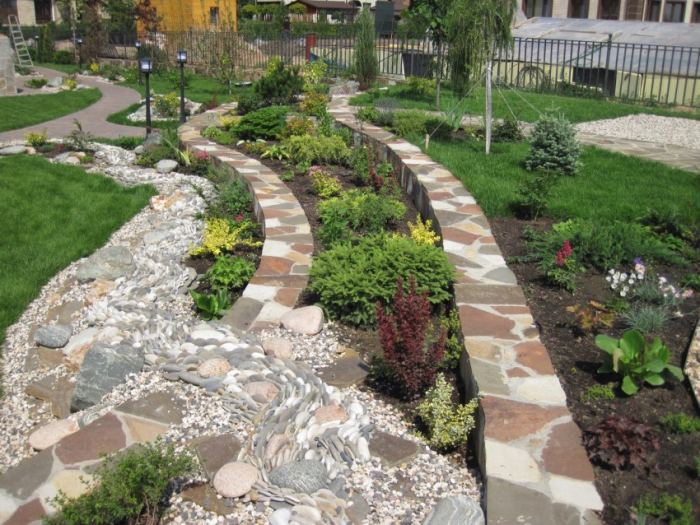
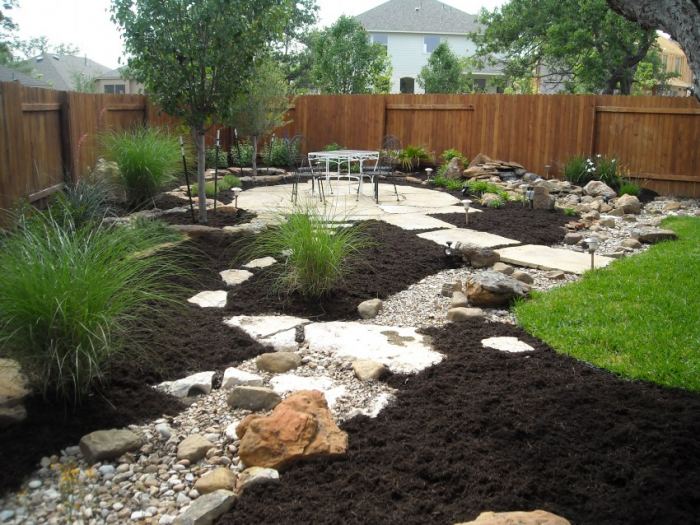
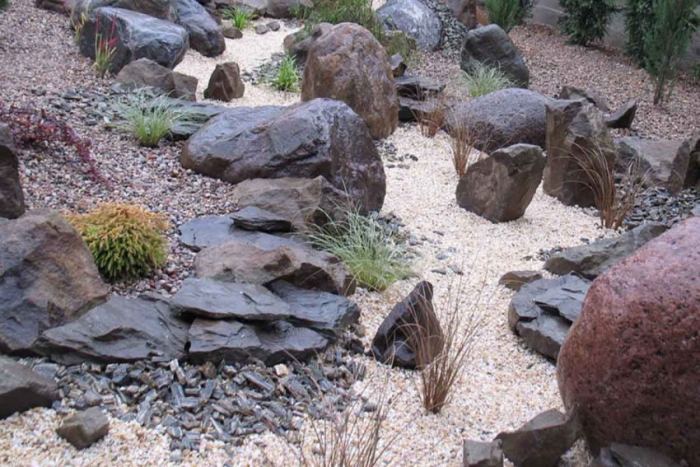
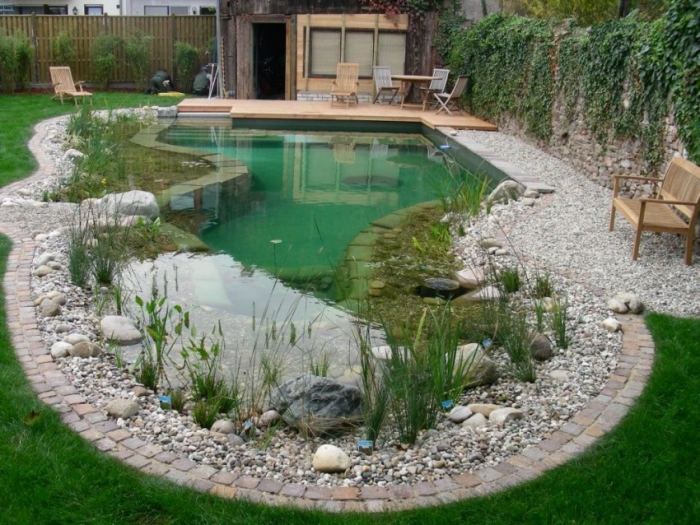
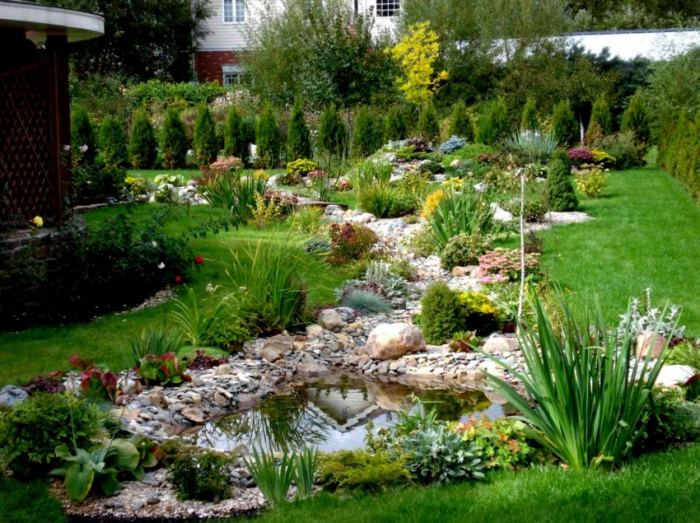




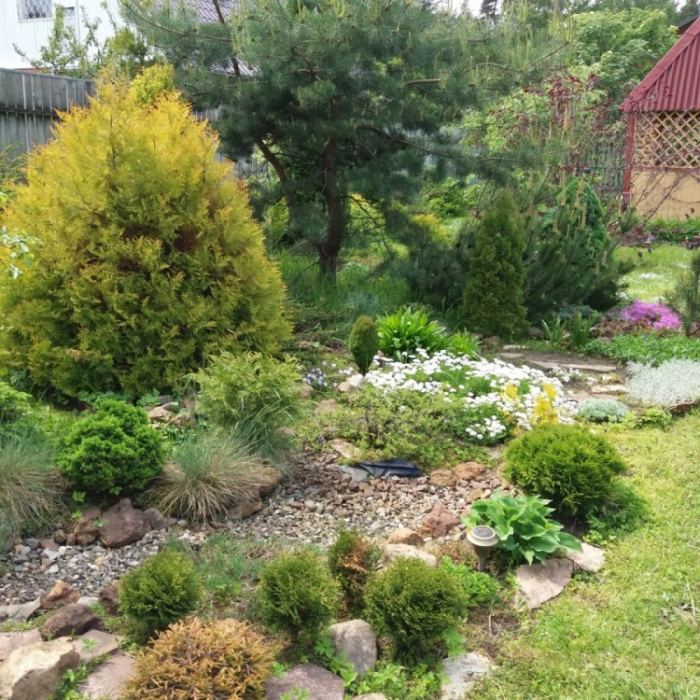
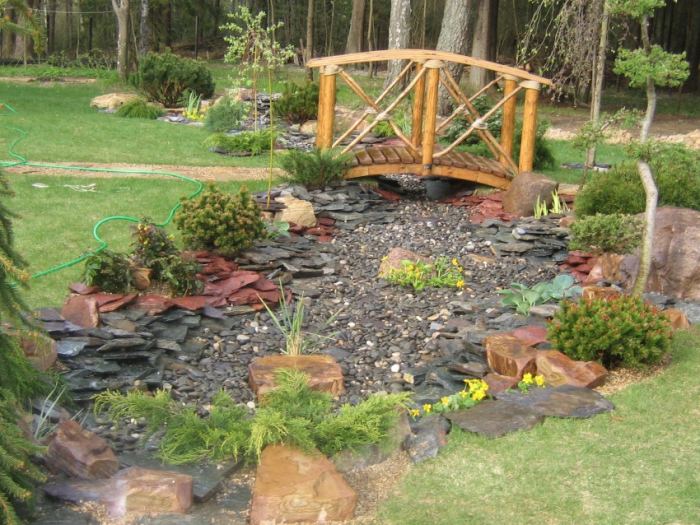
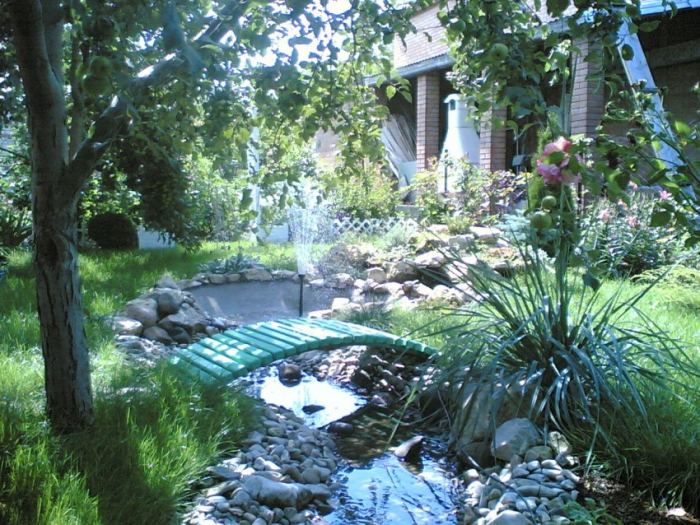
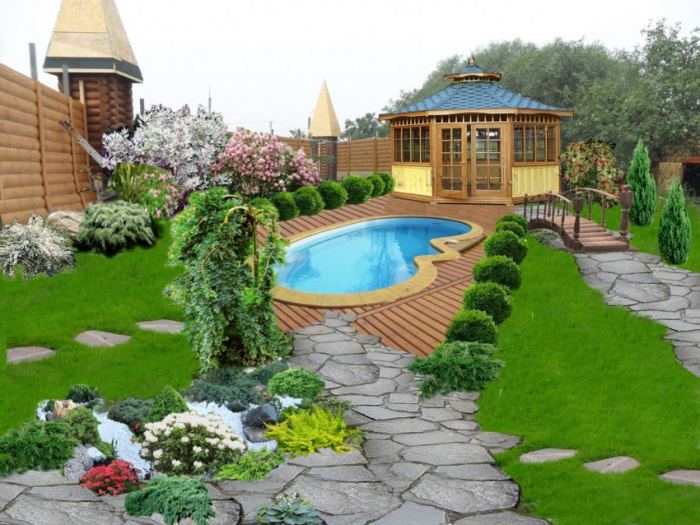
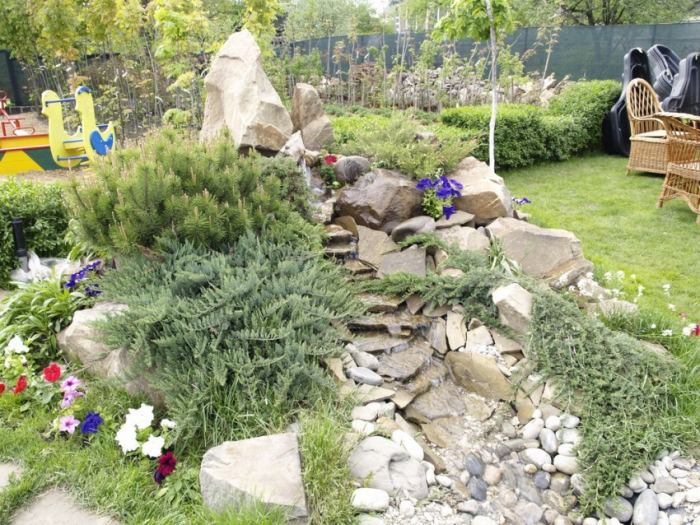



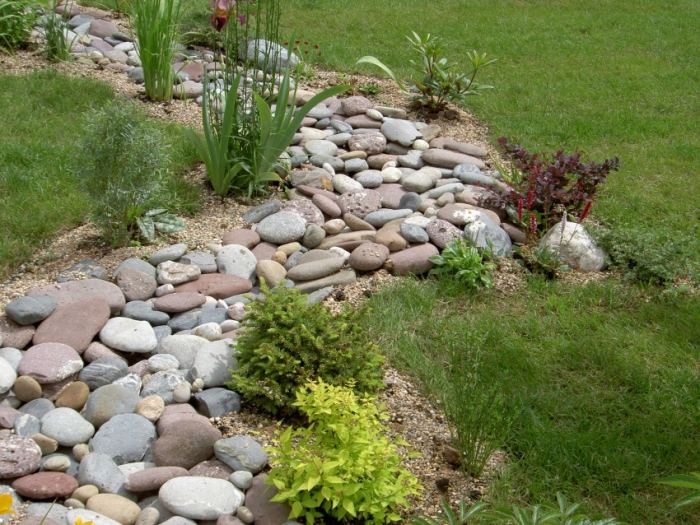
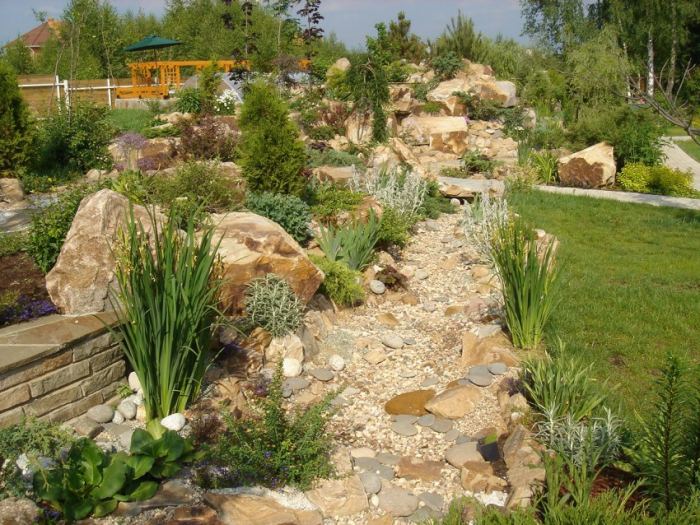
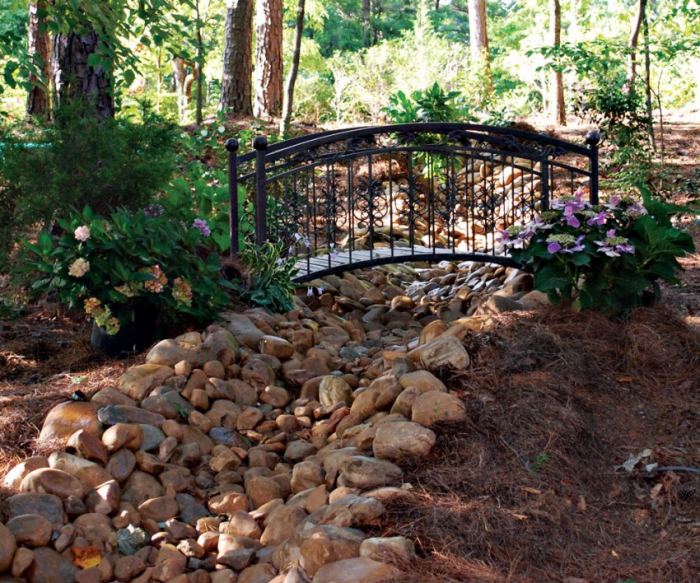
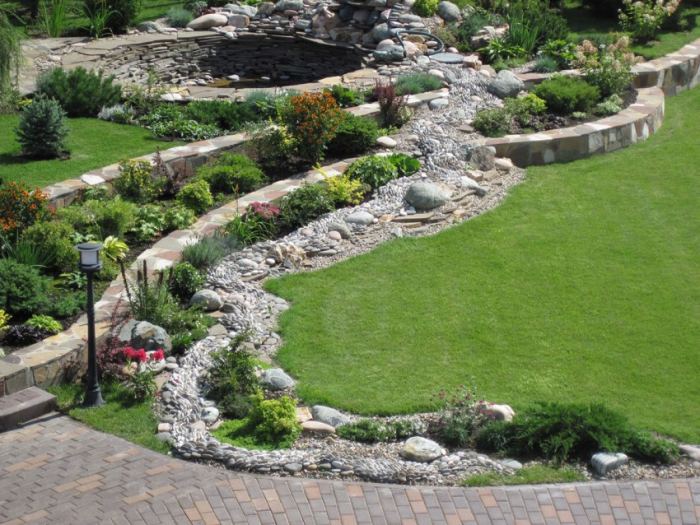




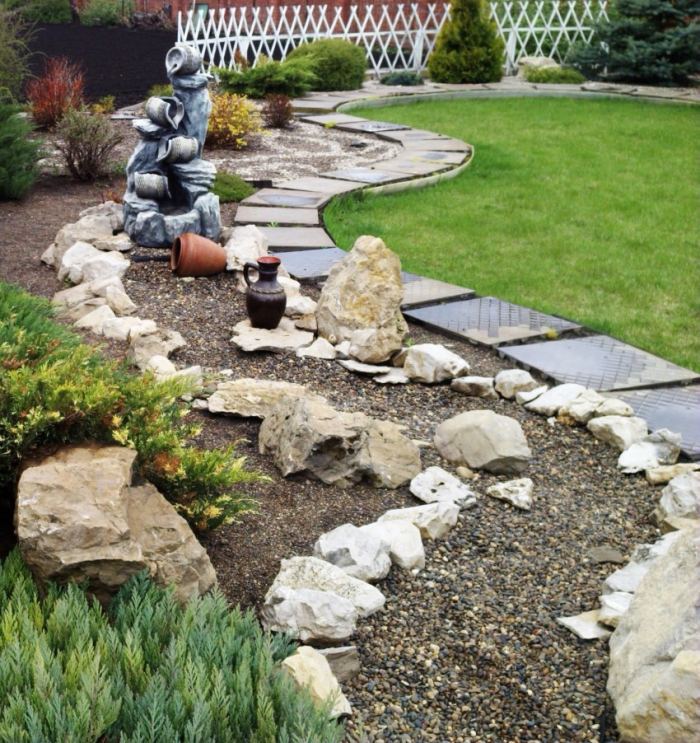
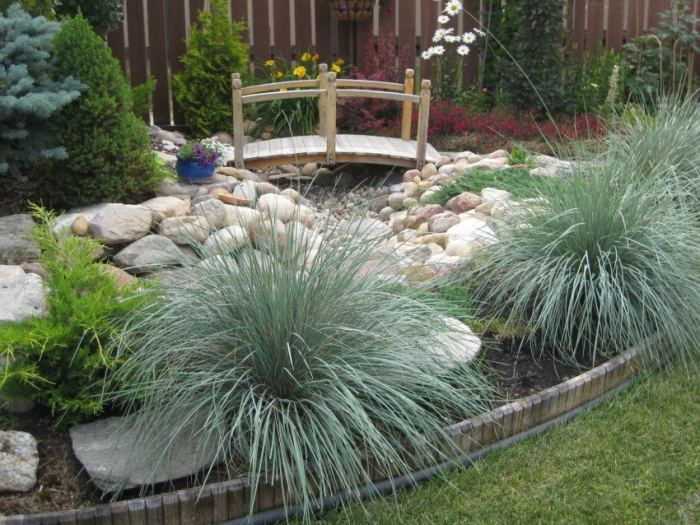
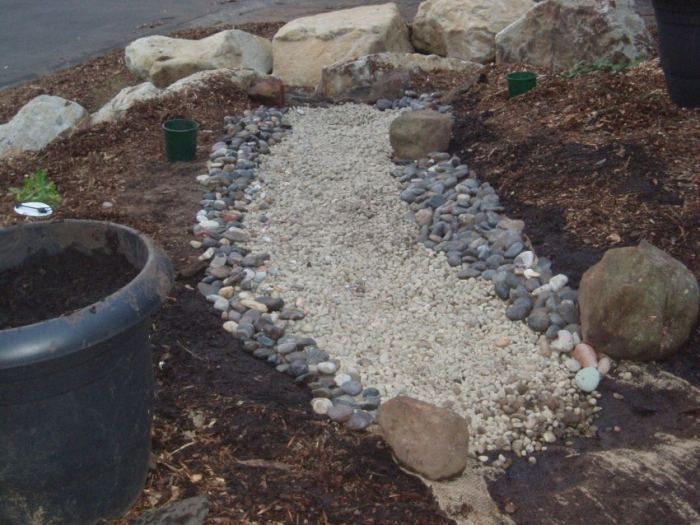

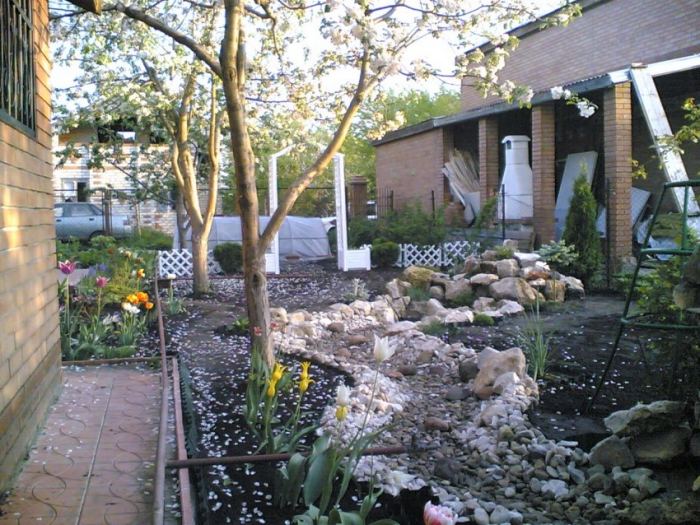

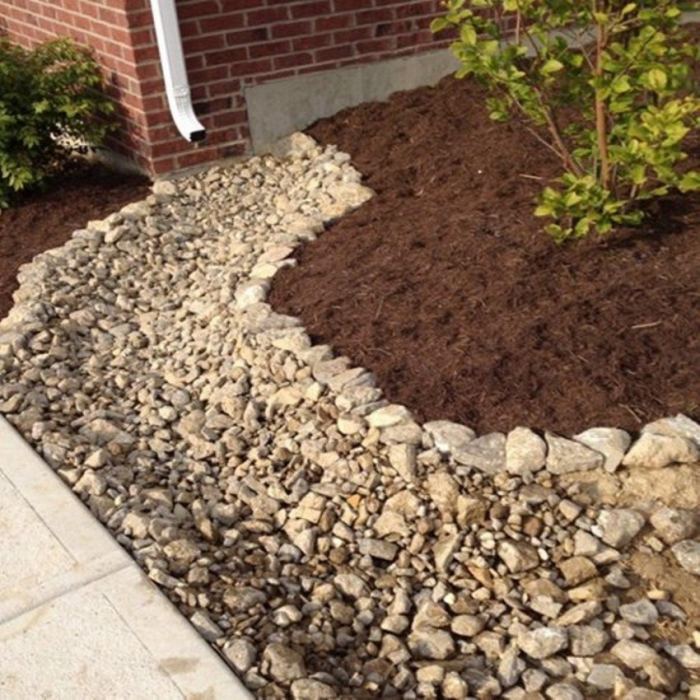

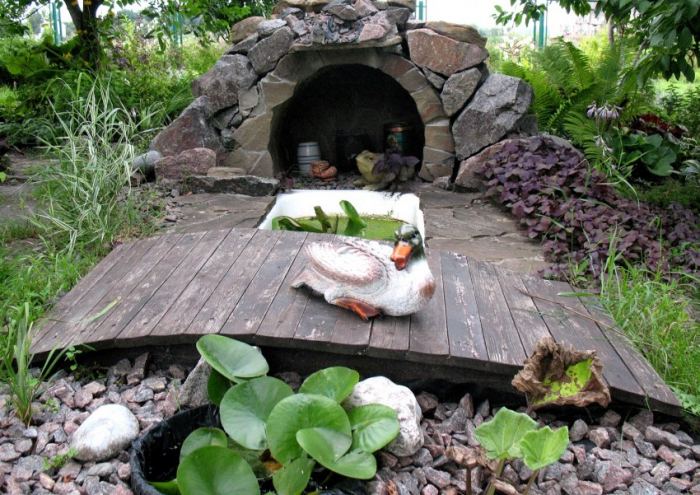
We also recommend viewing:
- Garden fountains for summer cottages
- DIY decorative flower beds
- Garden decor
- How to make a scarecrow for the garden
- Roof vane
- Decorative bridge for summer cottages
- DIY garden fencing
- Colored decorative chips
- How to make a bench with your own hands
- Crafts for giving
- Garden stones
- How to make a mailbox with your own hands
- Bird feeders
- DIY tire crafts
- Crafts from plastic bottles with your own hands
- DIY plastic bottle flower bed
- How to make a planter for the garden
- Decorative border
- How to make a sun lounger with your own hands
- DIY hammock
- Do-it-yourself pond in the country
- House for a well with your own hands
- Country washbasin with your own hands
- How to make a brick flower bed with your own hands
- How to make a waterfall on the site
- Sculptures for the garden
- DIY children's slide
- DIY sandbox
- Decorative gnomes on the site
- Washbasin for giving
- DIY decorative fence
- How to breed fish in a pond
- DIY nest of branches
- DIY figurines for the garden
- DIY garden swing
- Children's swing for home
- Illumination of the facade of a country house
- Garden Decorations
- Contemporary garden furniture
Features of the work
Despite the seeming simplicity, you need to know a few simple recommendations with which you can achieve an excellent result that will delight you for many years.
Preparatory activities
Instructions for conducting preparatory activities are as follows:
First, you need to prepare a tool for work, to dig a trench you need shovels, to remove sod and soil you need some containers, but even better to take a construction wheelbarrow, it will help not only to take out excess land, but also to bring stones in the future. (See also the article Fountains for a summer residence: features.)

The wheelbarrow will greatly simplify the workflow
Next, you should stock up stones, it is better to choose options for local rocks, for decorating the banks - even large boulders (although their delivery may cause some problems), while the bottom can be closed with small stones or even river pebbles, this will create an even greater resemblance to the real and will make the composition very attractive.
Advice! By choosing stones of different colors, you can make the composition even more interesting and original, the use of multi-colored fragments allows you to make your dry stream much more attractive.

You can even use blue pebbles, they will give your composition the look of a real stream.
The next stage is to think over the location of the composition on your site, it is best to pour out the outlines of the bed of a dry stream with the help of sand, so you can imagine how the finished version will look. In addition, if necessary, the outlines can be very easily changed with the same sand, it is better to spend time on this part of the work, it is much easier than to bury individual areas later.
The main stage

Simple country houses made of block containers look much better if the site is decorated with a dry stream with rich vegetation.
After everything you need is collected and the outlines are determined, you can start main works:
- First of all, a trench is dug, the depth of which can vary depending on the project and most often ranges from 20 to 40 centimeters. Naturally, the wider the trench, the deeper it must be, otherwise the appearance will not be very attractive. The shape of the depression should have smooth outlines, as in natural channels.
- Further, the plane is leveled with a rake. If necessary, individual sections are additionally leveled to obtain the most even and smooth slopes.
- In order not to subsequently fight weeds and not periodically remove them, it is best to cover the surface with some special material. An ideal option is geotextile, but, in extreme cases, a membrane material, a special film for summer pools, or even a simple burlap is also suitable. All slopes are carefully covered. Then you can proceed to further work.
Advice! If you need strength and protection from weeds, then you can apply a thin layer of concrete to the walls of a dry stream, but in this case it is advisable to lay the stones in a fresh solution, so they will be securely fixed and will not move in the future.
Laying stones begins from the banks of the future composition. First, the largest stones are laid, forming a channel, you can use options of various sizes, this makes it even more similar to natural compositions
It is important to install them as securely as possible so that later they do not fall from light touches.

You can create a whole composition, but it will take much more effort.
The channel is either laid out with flat stones, or covered with pebbles. As noted above, you can also use colored stones to create the illusion of water.
The area adjacent to the artificial channel is best planted with dense vegetation, it will look even more attractive
It is important to choose plants that will bloom during the summer, constantly replacing each other, so the site will be elegant all the time.
Decorative bridges and other similar structures can be used as additional decorations.

Children like these bridges.
Decor and decoration of a decorative stream
For the convenience of moving around the site and its decoration, a decorative bridge is thrown from one side of the channel to the other. This landscape element brings the stream to life and gives the impression that water is actually flowing in it. A beautiful bridge can become the main decoration of your courtyard.
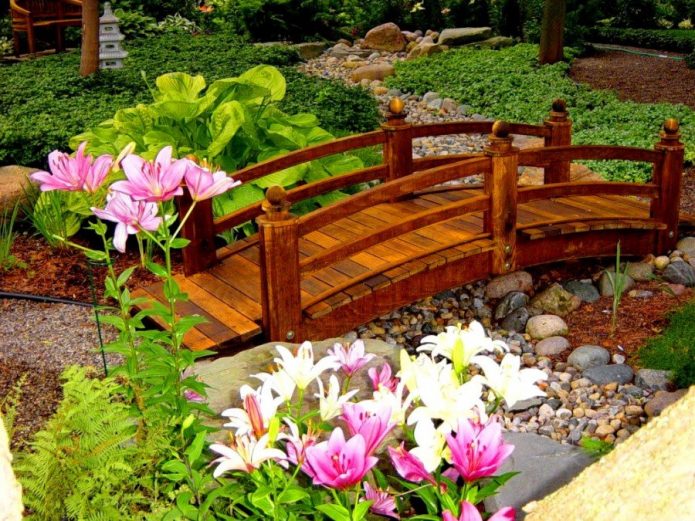
The bridge is made of wood or metal - this decor detail always looks spectacular on the site
To simulate the flow, the channel elements are painted with waterproof paints of blue, gray, blue. If you cover the stones with varnish, then the channel will look as if it is moistened with water, and the gaze involuntarily begins to search for it among the pebbles. By placing spotlights along the river bed, in the evening, the effect of the sensation of flowing water will be enhanced.
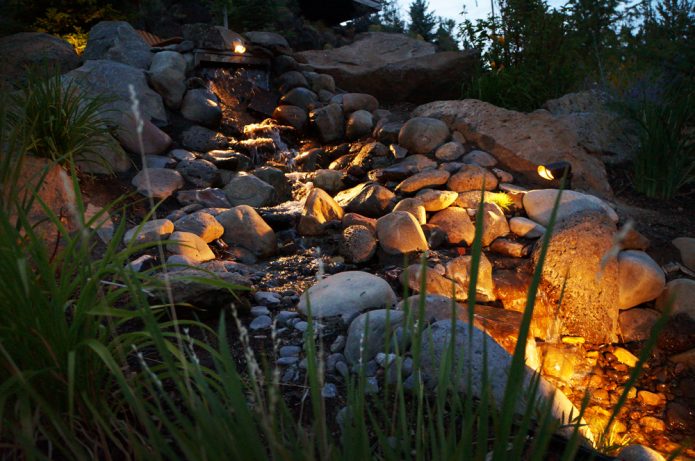
Stream illumination is made with LED flashlights, which accumulate energy during the day.
Near the stream, you can arrange a secluded recreation area. To do this, equip a stable platform and install a bench, a small-sized gazebo or a swing on it.
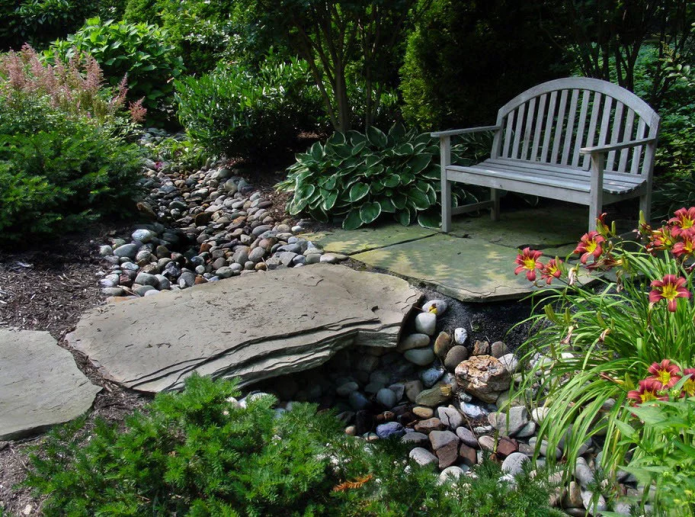
The bench is installed near the bridge to provide free access to it.
Sculptural compositions will be a good decoration option for landscape design. With their correct combination, the stream comes to life - it can be storks, swans, frogs or fairy elves, gnomes.

The sculptures are supplemented with lighting to make them look attractive in the evening
Sculptural compositions are also used to indicate the source from which the stream originates.In this capacity, stone grottoes, an earthen jug or pot, an antique statue or a fountain can be used.
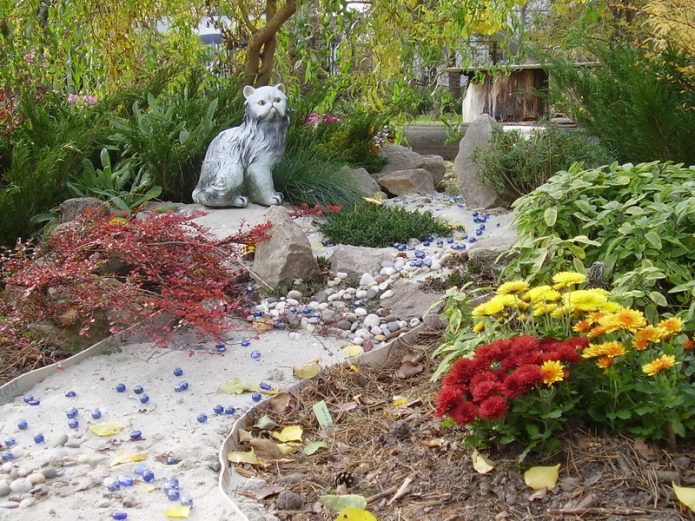
The source of the stream can be smooth, inclined or stepped - it all depends on the overall design concept of the decor
In addition to living plants, the artificial channel can be decorated with additional decorative elements. Various details will make such a composition cozy and original in its own way.
Solving possible difficulties
When creating an artificial channel and with subsequent care, it is rare, but difficulties arise that require an immediate solution. Most often, one has to deal with deformation of the channel, flooding of the reservoir with melt water or rainstorms, pollution. It is better to prevent some problems even when creating an artificial reservoir.
Flooding of buildings
Heavy downpours or melted snow often lead to flooding of a dry stream. A thick drainage layer - crushed stone or expanded clay - will help to avoid the problem. If the site is located in a lowland, it is recommended to lay a channel on a hill, otherwise a rapid flow of water will destroy the composition.
Strengthening the channel walls
Destruction of the walls is another problem that one has to face after creating a decorative element of the garden. To avoid trouble, reinforce the stones from which the channel is formed with concrete mortar. Planting plants on the shore of the reservoir will also help prevent shedding - after overgrowing, the roots will reliably hold the walls.
Large boulders are sliding from their places
To prevent large boulders from spreading, it is recommended to make a hard "pillow" - to lay a layer of rubble or pebbles, and carefully tamp them. If the boulder is large, it is advisable to fill the "pillow" with concrete. After installing the main element, strengthen the base with crushed stone, small stones, which are also recommended to be tamped.
Fallen leaves
The easiest way to get rid of fallen leaves is to plant plants that do not shed foliage for the winter or conifers. If you cannot do without deciduous perennials, purchase a garden vacuum cleaner in advance that will help remove litter.

If there are few plants shedding leaves, during the period of leaf fall under the bushes it is worth spreading polyethylene or burlap, which will prevent small leaves from getting into the gaps between the stones.
How to make a dry stream - step by step instructions
Diagram of the device of a winding dried up stream for the laziest
How to make a dry stream with your own hands
Place for a dry stream
Take a close look at the suburban area. Find any obvious imperfections in the terrain. Here we will veil them with the help of a winding bed of a rocky stream. The "dried" water flow will visually deepen the space, mask the flaws of a small area, visually make it larger and delimit it into functional zones.
Dry stream plan
Your first step in creating an original decoration should be drawing the outline of the future stream. We will draw the borders not with a pencil, but with ordinary sand. To do this, lay a string on the ground, imitating the natural bends of the stream (the more irregular and unexpected the turns are, the more natural the water flow on the site will look). The source of the stream is best located on a slight rise.
Digging a dry stream
Digging a dry stream "Dig!" No, this is not a phrase from Galygin's miniature, but a soft urge to action. So, when the plan is outlined, you can proceed to digging work.
When removing the top layer of turf, it is important to make the walls of the trench at an angle of 45 degrees
Drainage for dry stream
Drainage for a dry stream Let's leave a waterproof concrete base for a real stream with living water, and our decorative moat for the lazy will be covered with a dense (any!) Covering material. Construction (polymer) film, and water-permeable lutrasil, and even roofing material are suitable.
Dry bed bottom
Laying stone for a dry stream Laying the bottom begins from the foot of the channel, which must be covered with a layer of crushed stone or expanded clay (5 cm) and sprinkled with sand. And only then begin to lay the stream with stones of different sizes and shapes.
Dry Stream Stones
In our scheme (you can see its photo below), we suggest using large cobblestones, medium and small pebbles of a gray-blue hue. Basalt (rock of volcanic origin), shale (with excellent texture and color) or gneiss (metamorphic, coarse shale) are suitable. The stones in the artificial stream can be opened with a layer of varnish, making them "wet" or painted with a waterproof paint of blue, azure or light blue that shimmers in the dark.
Ear Stream Stones
Stacking stones
The place from which the water "flows" should look like a rock. Select the largest stones and build an embankment (places where the stones do not fit together should be filled with fine gravel).
Form the effect of a mountain stream from flat pebble stones. Place more convex stones around the edges.
Use the remaining large boulders to equip the coastline (it will look more natural if one coast turns out steeper, "rocky", and the other is shallow). Those. concentrate all large stones on one side of a dry stream, and decorate the other with smaller coarse stones.
Scatter small pebbles in the "shallow water".
Create a "stormy rushing current" with the help of a flat pebble laid on the edge.
In the middle of the "water" channel, you can put a hewn boulder, and with pebbles around it create the illusion of a "whirlpool".
The crevices of the stream can be filled with medium and large naked.
With the help of stones of a darker color, we create a feeling of depth in the stream, light pebbles, glass or plastic granules - water excitement.
The stones in a dry stream must be laid out so that no one doubts that they have been lying here all their stone life.
Are you afraid that the stones will be washed away by a strong stream of rainwater? Then in small portions fill the sole of the crushed stone with cement-sand mortar and "sink" the stones directly into it.
Dry stream with a bridge
A bridge made of a solid natural block is the most suitable option for a dry stream in the country. Do you want a more functional means of crossing? Take an ordinary log or make a wooden bridge with your own hands. Or even better - arrange a real ford through the seething mountain stream, spreading suitable stones along the surface of the stream.
Dry stream with a bridge
Plants for the coastal zone. The main thing here is not to overdo it with decorating the banks, otherwise the dried drain will turn into a flower bed
When selecting shrubs, cereals and flowers, it is important to take into account the composition of the soil on the site, its illumination, thermal and moisture regime
Dry stream
In landscape design, artificial reservoirs are especially popular. However, not all areas can be equipped with them. In addition, water bodies are always associated with such additional procedures as purification, purchase of purification systems, construction of a water supply system. For those who want to avoid additional hassle, but at the same time have a beautiful natural corner, a stream without water was invented.
A dry stream is one of the main elements in landscape design, namely in a rocky garden that spread throughout the world from the Land of the Rising Sun. The Japanese decorated various territories with dry streams as early as 700 years ago.
It was believed that the flow, which begins from a small beautifully designed source, passes throughout the site and ends in the form of a funnel, attracts positive energy to the owner of the home, contributes to the achievement of well-being and harmony.
Did you know? The most famous Japanese rock garden is the Kyoto one. It is located at the Reanji Monastery. Founded in the 15th century.It represents 15 stones placed on a rectangular platform, which are placed in such a way that from whatever side a person looks at them, they will see only 14 of them.
A dry stream is an imitation of a dried water stream, the bottom of which is covered with stones, pebbles, gravel, sand, and ornamental plants are planted along the banks.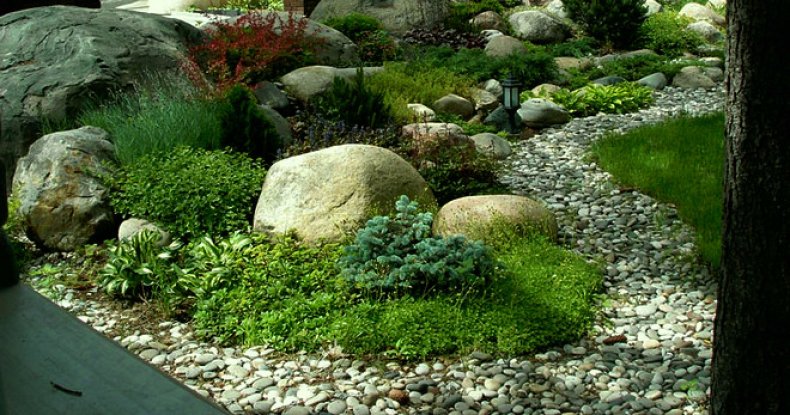
The advantages of this element over a real reservoir are that it:
- practically does not require maintenance;
- will require minimal investment;
- done in just two to three days;
- looks beautiful at any time of the year;
- does not attract harmful insects;
- allows you to hide landscape defects;
- looks good and fits into any area;
- can function as a drainage ditch;
- can mask communications (sewer hatches, cables, pipes, etc.);
- does not limit the choice of plants that can be planted along its banks;
- is safe for small children.
A dry stream visually enlarges the area of the site, separates various landscape zones, and enhances the impression that other objects make.
Did you know? The term "landscape design" originated in the twentieth century, but the roots of the art itself go back to ancient times and lead to Mesopotamia — it was there that the first attempts to cultivate garden plots were made. In ancient Greece, parks and gardens were created by human hands, and the earliest mentions of ancient Roman landscape design date back to 65-68 BC.
It is interesting: Mirror in the interior of the hallway - we study in general terms
Source construction
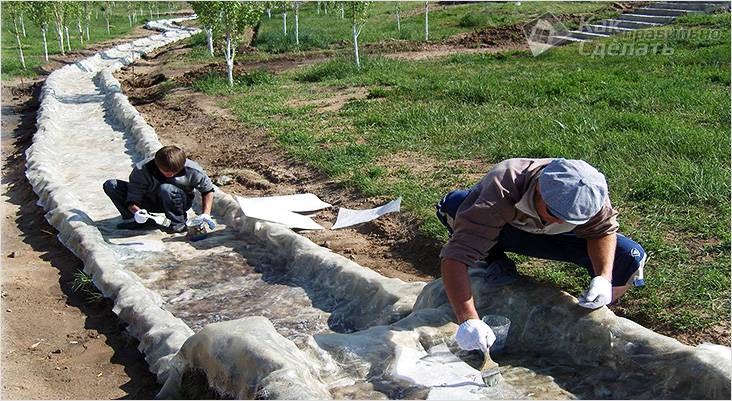
Suppose you have already decided on the relief of the source and its location. Now is the time to arm yourself with rope and pegs and walk along the riverbed of the planned source. Drive in the pegs close to each other, connecting them with a rope. Compliance with geometric shapes in this case is inappropriate.
The next step is to dig the ground under the bed. If the slope allows, then add steps that will serve as small sills. If you do not have a desire to make them, then use large boulders as sills that can be fixed with concrete mortar. Clear the bed of stones and root residues. Then tamp the ground.
If you want to plant plants along the coast of the source, then expose the waterproofing layer, and then make a trench for the mouth. Sprinkle it with sand or gravel 5–7 cm. Then cover it with geotextiles with a margin around the edges. Then pour water on the canvas to moisten it. This is a necessary measure, because, otherwise, the geotextile will not fit snugly around the mouth. And this, as you might expect, will spoil the appearance of the structure.
At the edges, the geotextile should be secured with large stones. In the middle of the channel, masonry is made, consisting of flat stones and concrete mortar. Then another layer of concrete is laid, which is decorated, for example, with pebbles.
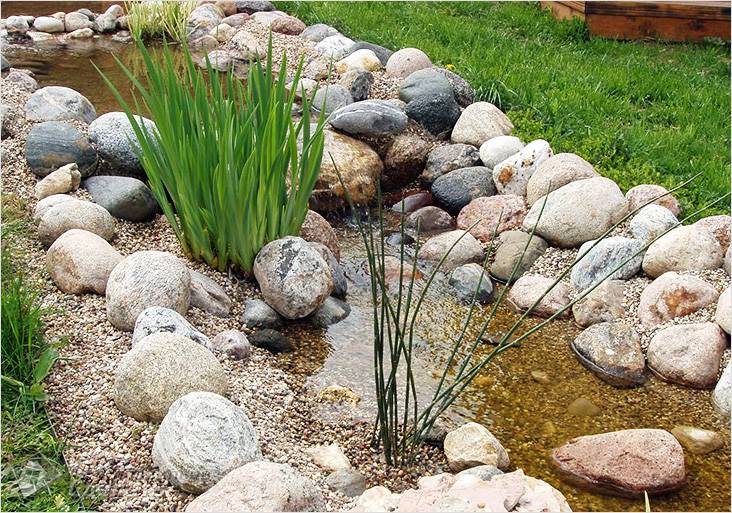 Plant selection
Plant selection
Now you need to dig grooves up to 10 cm deep parallel to the riverbed. They will fit pipes from the pump. Fill them up, and then mask with turf. Now you need to connect the pump and start the water. The trickle is ready! There are other ways of building streams, for example, its dry analogue.
Landscaping and dry stream
Do not forget that by following the rules and stages of creating a "dried up channel" you will turn your summer cottage into a piece of paradise with your own hands. Do not be afraid to take care of the stream, it will not be difficult, but even interesting - this is so for the future.


It is important - a spectacular reservoir serves not only for decoration, it is capable of performing some more tasks:
- with its help, stormwater wastewater will drain smoothly;
- due to the retention of moisture under stones and pebbles, the plants do not have to be watered often;
- a dry stream in landscape design will become the border between the zones in the garden;
- the soil will not become vulnerable and will not succumb to erosion;
- the garden will visually acquire large dimensions.

Flowering plants can be used instead of small stones. But the stream will be beautiful during flowering.

The right stream for landscaping will create a unique look in the garden, as if it had recently dried up and had water in it. And immediately after the rain, your creation will heal again and sparkle with the reflections of the sun's rays.
Feel free to use your imagination, read the advice of experts and get to work. Carefully study all the stages of creating a stream, purchase the necessary materials and plants. Hurry up, because summer warm days pass quickly.

Plant selection and planting
When the outlines of the stream are finally formed, they begin to decorate it. For this, flowering plants, ornamental grasses, deciduous and coniferous plantings, small shrubs are suitable.
Flowering plants
Excessive floral abundance and a riot of colors do not need to be used to decorate the stream. Plants located in small groups will look appropriate near the decorative channel:
- iris warty, Siberian;
- Ostrovsky's bow;
- phlox subulate;
- Astilba Arends;
- Buzulnik Przewalski;
- common primrose;
- daylily hybrid;
- herbal carnation;
- bell of Portenchlag.
When choosing plantings, it is necessary to select specimens that are in harmony with each other in shades of flowers.
Photo: flowering plants for a dry stream
If you want to make a stream of water from flowers, replacing stones with them, use undersized plants: lobelia, allisum, blue muscari.
Conifers
In large adjoining territories, compact evergreen conifers can become an ornament for the stream.
The higher the size of the ephedra, the more spacious the landscape area should be, so as not to take attention from the stream and look harmonious with it:
- creeping juniper;
- mountain pine, dwarf;
- spruce green, blue;
- thuja western, golden;
- dwarf fir, balsamic, Korean.
Landscape designers use dwarf species of spruces and junipers to create strict and laconic compositions, while plants are arranged in groups or singly.
Photo: conifers for decorating a decorative channel
Evergreens are good because they look spectacular at any time of the year, do not require special care after planting.
Ornamental grasses
In natural conditions, various types of herbs grow near water bodies. By planting such plants along the banks of the stream, you create the most realistic atmosphere for the entire composition:
- hybrid sedge Frostyd Curls;
- gray fescue;
- sandy spikelet;
- Chinese miscanthus;
- lake reeds;
- imperate.
Ornamental grasses are perennials that grow rapidly and look attractive all year round.
Photo: types of ornamental grasses to decorate the landscape
A variety of grasses look especially impressive both in a single and in a group arrangement, with their help they decorate the banks and small islands located in the bed of a dry stream.
Deciduous ornamental plants
Plants with catchy, expressive foliage bring a special beauty to the overall picture of the banks of the artificial riverbed - they grow in herbaceous bushes from 50 to 90-100 cm in diameter:
- hosta plantain, Liberty;
- badan heart-leaved;
- creeping tenacious;
- bruner large-leaved.
Herbaceous perennials with decorative leaves delight with their beauty from spring to late autumn, they are not capricious and undemanding to care.
Photo: plants with decorative foliage
Plants with large leaves go well with flowers, herbs, conifers. Many species can grow in conditions of lack of sunlight.
Ground cover plants
In nature, viable plants grow on stony infertile soils, adapting to a small amount of moisture, a lack or excess of sunlight, sharp gusts of wind:
- bryozoan subulate;
- sedum caustic;
- felt splinter;
- creeping thyme;
- basilicum soapwort.
By decorating the banks of the stream with these types of plantings, you will achieve the maximum resemblance to the natural environment.
Photo: ground cover plants for stream bank design
Ground cover species are undemanding to care for, take root well and grow, sometimes it is necessary to limit their growth.
Arrangement of the channel
After the design work, they start laying the channel. Its marking is done along the trajectory, width and depth to give the desired shape. In the process of excavation, roots, stones are removed, the soil is tamped, and a sandy base is laid.
The next step is to make waterproofing. The method is selected depending on the project: membrane or coating. A layer of sand is poured over the soft waterproofing materials for a snug fit. In the tank where the pump will be located, a layer of PVC film glued at the joints is additionally laid. The coastline is reinforced with mortar and lined with stones or pebbles.
How to make a dry stone stream
Stone compositions are fantasy design objects subject to oriental culture and elements. A dry stream made of stone creates the illusion that there is real water on the site.

It looks like a dry source of water, which, due to the lack of precipitation, has long dried up. In fact, this is a kind of stone composition that creates such an illusion.

Looking at a dry stream in landscape design, you might think that this is a dry stream, and the first thing that catches your eye is the amazing shape of the riverbed.


You can make the composition a little differently, leave an empty bed, imitating the fact that the water has left the stream, leaving it due to drought. An empty channel can be sprinkled with pebbles or sand a little.


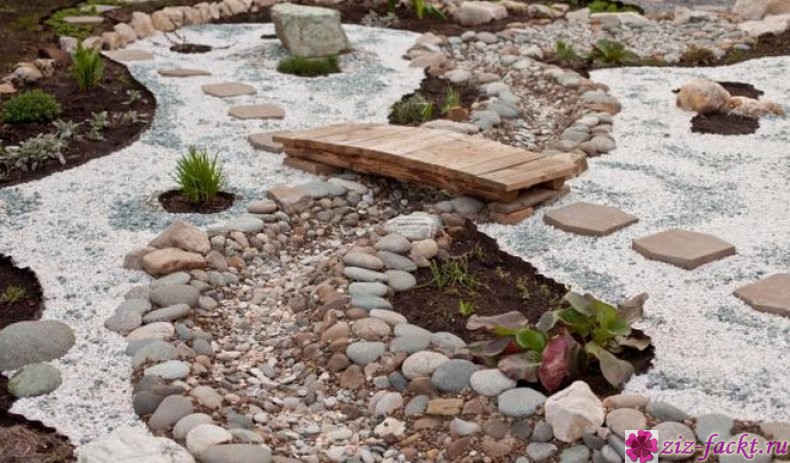


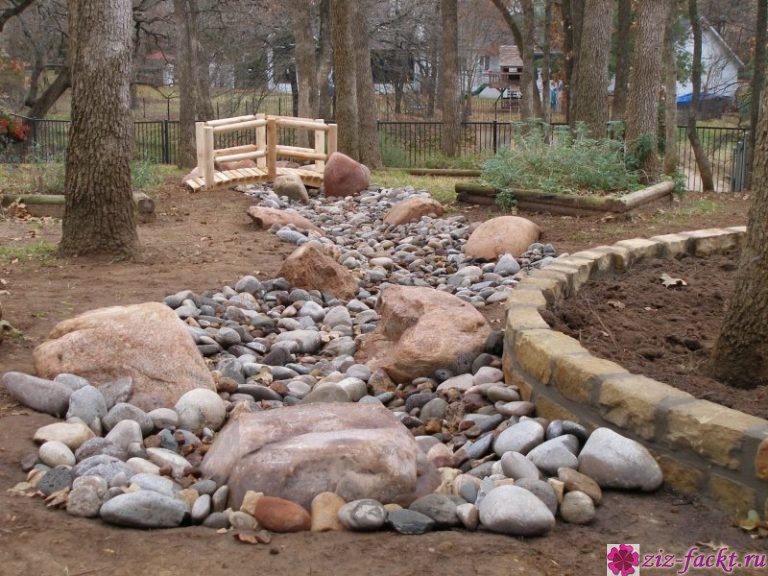
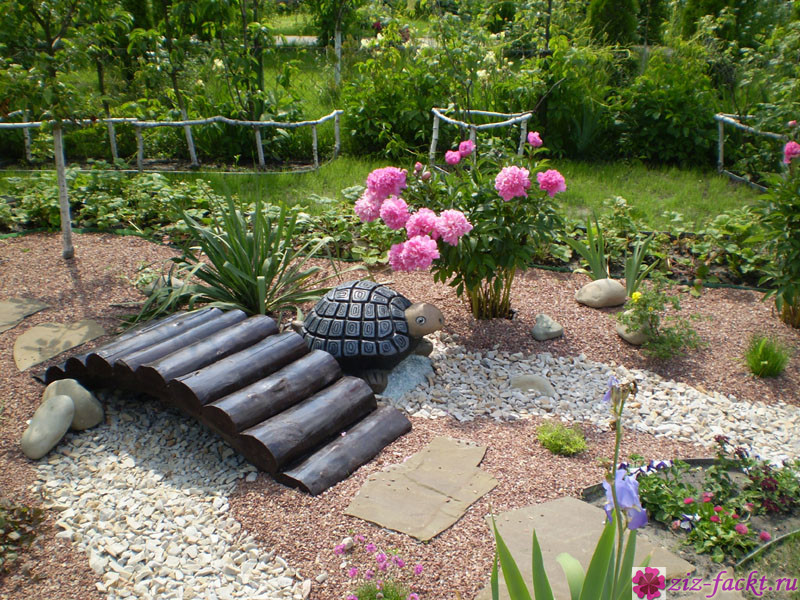

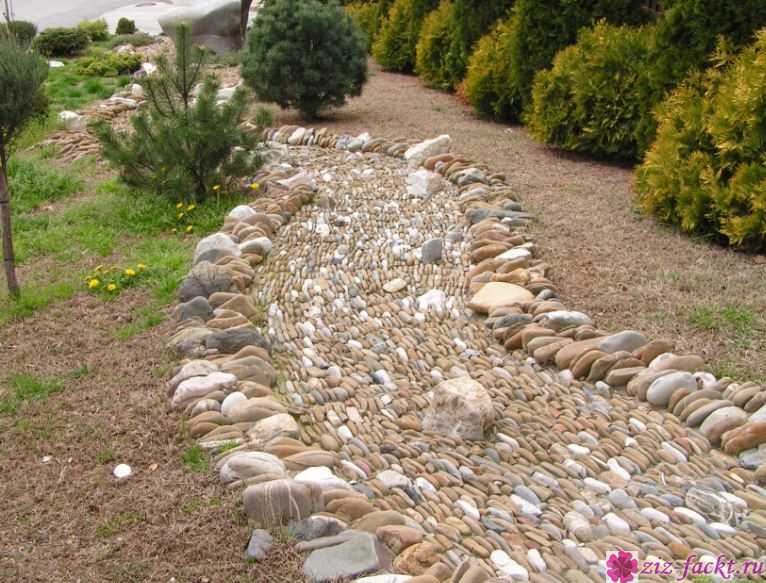

Follow-up care
Water in any body of water quickly becomes dirty and takes on a greenish tint if neglected. Also, do not forget that there is an electrical appliance inside, which also requires proper maintenance and care.
 Artificial stream requires careful maintenance, regular cleaning
Artificial stream requires careful maintenance, regular cleaning
In order for the stream to decorate the territory for a long time, you must follow the rules for caring for it:
- monitor the pump: clean and change filters, check the integrity of the hoses, etc .;
- restore the required water volume as needed;
- with the onset of cold weather, drain the water, remove the pump and cover the stream and reservoir;
- regularly clean the reservoir from stones, dirt, silt;
- take care of decorative structures;
- completely change the water in case of pollution;
- take care of plants.
When planning and arranging a reservoir, you should not save on materials and a pump and neglect landscape features, then you will have the opportunity to spend more than one magnificent evening in a gazebo by the stream.




